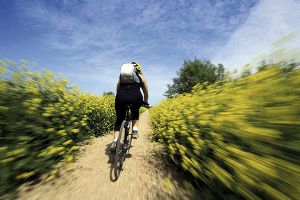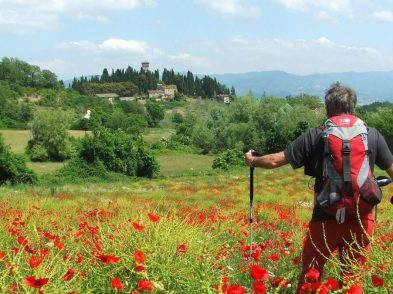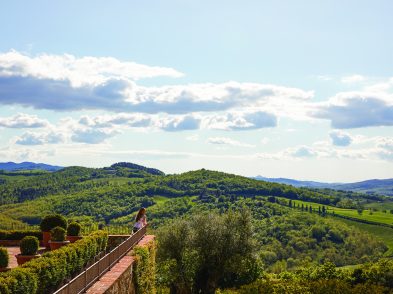“You live in Pistoia, how quaint” was the response of a friend from Florence when I told him about my place of residence. His reply pretty well sums up the attitude of many Florentines about the city 20 miles to the northwest. Guide books to Italy, on the other hand, usually recommend Pistoia as well worth a one-day visit. It surely merits the 45 minute train ride from Florence.
First, a little folklore. The claim that the word “pistol” (pistola in Italian) is derived from Pistoia is not supported by scholars. Pistoia did give its name to a type of two-sided hunting knife called a pistolese in Italian. Connecting Pistoia with guns and knives has, however, a rationale. In late Medieval and Renaissance times the “feudin’, fussin’ and fightin’” in Pistoia were particularly violent and intense, even by Tuscan standards. Dante and Machiavelli commented negatively about Pistoia in this regard. Michelangelo called the Pistoiese “enemies of heaven.” Put the stories of its dark past aside. Pistoia today is a safe, beautiful, city with attractions that cause it to describe itself as a “City of Art.”
Even more than Florence, Pistoia is a “walkable” city. From the train station you head directly north, starting on Via XX Settembre for three blocks to Via Cavour (the recently reopened Café Globo is on your left) and turn right for one long block (past the striped church of San Giovanni Fuorcivitas on the right that we will visit later) to the Post Office (Via Roma) where you turn left.
Just past the Post Office is the Cassa di Risparmio . Built to mimic a Florentine Palazzo, it was in fact completed in 1905. The decorations inside treat Renaissance artistic themes in the late 19th century Liberty style. The large lobby often hosts art exhibits, frequently with a free catalogue provided.
Continuing down Via Roma, soon you enter the jewel of Pistoia, The Piazza del Duomo – clearly one of the most beautiful town centres in Tuscany. Grab a town map (and some pamphlets for visitors) at the Tourist Centre just across the street from the octagonal Baptistery. While at the Centre, check to see when the city’s bell tower is open for tours; on an exceptionally clear day you can see the outline of the Duomo in Florence from its heights.
The façade of the Cathedral is topped by two statues, St. Zeno and St. Jacopo (the patron of pilgrims), the city’s two patron saints. Pistoia is along the Via Francegena, the pilgrimage route going from France either to Rome or to Santiago di Compostella in Spain. Tourist revenue was important in Tuscany even 500 years ago. Inside the Duomo there is one of the town’s prime artistic treasures – a large silver altar of St. Jacopo completed in 1456 after almost two centuries of construction .
Unfortunately, you have to find the sexton to gain admission to its location if you want to examine it closely.
On the town hall on the eastern side of the square, you see the six Medici balls, a reminder of Pistoia’s long tenure in the Florentine sphere of influence. Inside is the Civic Museum. The museums of Pistoia don’t come close to rivaling the Uffizi or Pitti Palace, but the costs are modest and there are no lines. Within the Civic Museum there are certainly works that make a visit worthwhile. As you face the town hall there are little streets to its right and left; take either one for a short block to Via Filippo Pacini and after a left turn you will almost immediately see the famous façade of the Ospedale del Ceppo with the seven ceramic panels representing the various virtues of mercy (feed the hungry, clothe the naked, etc). Six of these are works of the Della Robbia workshop. The seventh, which is faded, is actually a newer one done by followers of Della Robbia who clearly had not conquered the techniques of the master. In addition to the famous panels, you will also see the Medici shield again.
Heading west from the old Hospital on Via Delle Pappe, in a few blocks you come to Via S. Andrea where a right turn is called for. The church of S. Andrea on the left contains a second famous artistic masterpiece of Pistoia – the pulpit by Giovanni Pisano. Be sure to have 50 centesimo with you to pay for the lights to illuminate it.. The pulpit is reminiscent of a similar Pisano work at the Duomo in Pisa. Backtrack from the church to Via Abbi Pazienza and turn right. Soon you come to Church of Saints Prospero and Filippo on your right. Take a peek in this church and then go to the left of its main entrance where (along Via Bozzi) is the door to the Library Fabroniana that is open ordinarily on Tuesdays and Thursdays. The main library room is an exquisite wood-paneled hall built in the 18th century to house the personal collection of Cardinal Carlo Agostino Fabroni
From this church go directly south on Via Curtatone e Montanara to the first cross street and turn right onto Via Della Madonna. In half a block, you arrive at the Basilica of S. Maria dell’ Umiltà. It is the dome (a work of Giorgio Vasari) of this church that you see as you approach Pistoia – not the Duomo. In fact, the dome of this church is the third largest in Italy after St. Peter’s and the one in Florence. The outside is unfinished, but the inside in quite attractive, including the central location of the portrait of Mary that miraculously wept in 1490 and led to the construction of this church as an appropriate location for the religious icon.
Retracing your steps to Via Curtatone e Montanara, this time turn right and go half a block to Via Cavour where you turn left. On your right you come to the church of S. Giovanni Fuorcivitas. Its name indicates that it was outside the first set of walls of the city which encompassed a small area indeed. It’s good to have a flashlight with you in this church; a few of the artworks are in dark corners. Here is the third of Pistoia’s premier works of art, a Visitation in white terra cotta attributed to Luca Della Robbia.
Exiting the church, turn left and then immediately left again down Via Carducci. Many streets in Pistoia’s centre are named for the occupations that formerly were located there, such as Via degli Orafi (goldsmiths) or Via dei Fabbri (blacksmiths). Fortunately this medieval system was not followed for Via Carducci, which would have been Via delle Puttane (Street of Whores)! After one block on Via Carducci, turn left at Via Corso S. Fedi. You are now at the Museum Marino Marini. Seen more than enough Sacred Conversation or Nativity paintings in Italy? Here is a museum of the modern works of Pistoia’s most famous 20th century artist. Its emphasis on his graphic art complements his sculptures found in the Marino Marini museum in Florence. Don’t miss the frescoes on the walls of the former Tau convent next door to the museum.
Our little tour has covered the high points of central Pistoia. The literature you picked up at the Tourist Office describes many other places of interest. Pistoia, unlike Florence, is not home to exclusive shops featuring the merchandise of the most famous Italian and European designers, but there are stores featuring clothes and other items at various levels of luxury and price. On Wednesday and Saturday mornings there is a large travelling market in the central Piazza and adjacent streets. Everyday, there is a fruit and vegetable market in the Piazza Della Sala close to the Duomo Square. Restaurants are numerous at prices more modest than those in Florence. Some personal recommendations include: Trattoria Dell’ Abbondanza, Via dell’ Abbondanza; La Bottegaia, Via del Lastrone 17; Boccon di Vino, Corso Gramsci 83; and Lo Storno, Via del Lastrone 6/8. The last is the most informal of these. Across from the Basilica of S. Maria dell’ Umiltà is the Bang, Fusion Bar – an American bar with both American and Italian food, as well as American pastries. On the same street (38) is Pizzeria Dell’Arca (evenings only), where you find perhaps the best American pizza maker in Italy.
When I first saw Pistoia, my immediate love affair with the city led me to move there within a year. Others will be less bowled over, but few who visit fail to be impressed by the beauty and attractions of this largely unknown jewel so close to Florence.






